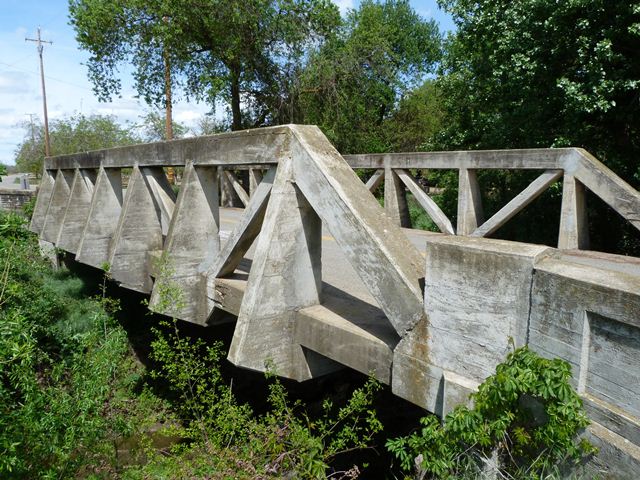We Recommend:
Bach Steel - Experts at historic truss bridge restoration.
BridgeHunter.com Phase 1 is released to the public! - Visit Now
Kilburn Road Bridge

Primary Photographer(s): Nathan Holth
Bridge Documented: April 5, 2013
Rural: Stanislaus County, California: United States
1918 By Builder/Contractor: Pacific Construction Company and Engineer/Design: D. M. McPhetres
Not Available or Not Applicable
60.0 Feet (18.3 Meters)
62.0 Feet (18.9 Meters)
19.7 Feet (6 Meters)
1 Main Span(s)
38C0168

View Information About HSR Ratings
Bridge Documentation
This bridge's future is at risk!
Bridge Status: This historic bridge is at risk for demolition and replacement!This bridge is a very unusual bridge with an unusual history. Although it looks like a concrete truss bridge, it actually is a steel truss that was reused by encasing it with reinforced concrete. The bridge is not a simple concrete-encased metal truss bridge because not only was concrete added around the metal truss, a substantial amount of reinforcing rods and wires were added alongside the truss within the concrete. The steel truss and reinforcing rod system work together to give the bridge its load-bearing capacity. Therefore, the best way to think of the bridge today is a combination of a reinforced concrete truss and a steel truss. The metal truss was reportedly built in 1910 or 1906 depending on the source consulted. The bridge as seen today was constructed in 1918. If the date for the metal truss is correct, it did not have a long service life. Based on the original plans for the bridge, the metal truss structure was a very lightweight structure composed mostly of paired angles. It likely did not take the county long to realize that the truss was not very strong and would be better served by strengthening it to enable it to reliably carry heavier loads. The steel truss itself is a Warren truss, but it is not subdivided. When the concrete strengthening project took place, the bridge was turned into a subdivided Warren truss by adding verticals and floor beams. Therefore, every other vertical member and floor beam is pure reinforced concrete with no steel truss component inside.
Thanks are due to Stanislaus County for providing a copy of an original 1918 plan sheet for this bridge, which unraveled the mystery behind this unique bridge. HistoricBridges.org adapted the diagram on this page from this plan sheet to show the parts and construction of this bridge.
View Archived National Bridge Inventory Report - Has Additional Details and Evaluation
View Historic Bridge Inventory Sheet For This Bridge
![]()
Photo Galleries and Videos: Kilburn Road Bridge
Bridge Photo-Documentation
Original / Full Size PhotosA collection of overview and detail photos. This gallery offers photos in the highest available resolution and file size in a touch-friendly popup viewer.
Alternatively, Browse Without Using Viewer
![]()
Bridge Photo-Documentation
Mobile Optimized PhotosA collection of overview and detail photos. This gallery features data-friendly, fast-loading photos in a touch-friendly popup viewer.
Alternatively, Browse Without Using Viewer
![]()
CarCam: Southeastbound Crossing
Full Motion VideoNote: The downloadable high quality version of this video (available on the video page) is well worth the download since it offers excellent 1080 HD detail and is vastly more impressive than the compressed streaming video. Streaming video of the bridge. Also includes a higher quality downloadable video for greater clarity or offline viewing.
![]()
CarCam: Northwestbound Crossing
Full Motion VideoNote: The downloadable high quality version of this video (available on the video page) is well worth the download since it offers excellent 1080 HD detail and is vastly more impressive than the compressed streaming video. Streaming video of the bridge. Also includes a higher quality downloadable video for greater clarity or offline viewing.
![]()
Maps and Links: Kilburn Road Bridge
Coordinates (Latitude, Longitude):
Search For Additional Bridge Listings:
Bridgehunter.com: View listed bridges within 0.5 miles (0.8 kilometers) of this bridge.
Bridgehunter.com: View listed bridges within 10 miles (16 kilometers) of this bridge.
Additional Maps:
Google Streetview (If Available)
GeoHack (Additional Links and Coordinates)
Apple Maps (Via DuckDuckGo Search)
Apple Maps (Apple devices only)
Android: Open Location In Your Map or GPS App
Flickr Gallery (Find Nearby Photos)
Wikimedia Commons (Find Nearby Photos)
Directions Via Sygic For Android
Directions Via Sygic For iOS and Android Dolphin Browser
USGS National Map (United States Only)
Historical USGS Topo Maps (United States Only)
Historic Aerials (United States Only)
CalTopo Maps (United States Only)



